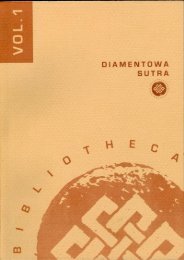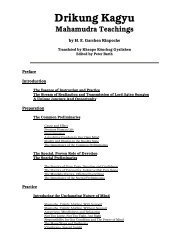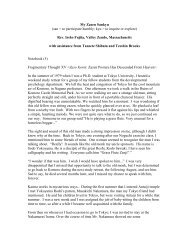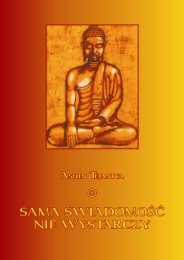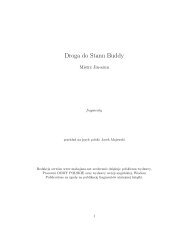3 - Computing in the Humanities and Social Sciences
3 - Computing in the Humanities and Social Sciences
3 - Computing in the Humanities and Social Sciences
Create successful ePaper yourself
Turn your PDF publications into a flip-book with our unique Google optimized e-Paper software.
signs (expressions) of <strong>the</strong>ir respective l<strong>in</strong>guistic sounds (contents), as <strong>in</strong> <strong>the</strong> case of <strong>the</strong><br />
graph //a// which st<strong>and</strong>s for <strong>the</strong> sound /a/. At this level of use, shittan graphs are not<br />
ideographs but “phonographs” (representation of vocal sounds). In esoteric Buddhism,<br />
however, this is just <strong>the</strong> most superficial usage of <strong>the</strong> mystical script.<br />
However, Buddhist texts also treated <strong>the</strong> Shittan graphs as vehicles of conceptual<br />
mean<strong>in</strong>g, such as <strong>the</strong> ma<strong>in</strong> tenets of Buddhism, which was usually <strong>in</strong>dicated <strong>in</strong> Ch<strong>in</strong>ese<br />
characters. In this case, <strong>the</strong> shittan were identified, structurally at least, with <strong>the</strong> Ch<strong>in</strong>ese<br />
language <strong>and</strong> graphic system, s<strong>in</strong>ce <strong>the</strong>y were considered as expressions of a certa<strong>in</strong><br />
conceptual content—<strong>in</strong> o<strong>the</strong>r words, as ideographs. The supposed similarities of <strong>the</strong><br />
shittan letters with <strong>the</strong> Ch<strong>in</strong>ese characters were fur<strong>the</strong>r streng<strong>the</strong>ned by legends on <strong>the</strong><br />
orig<strong>in</strong> of writ<strong>in</strong>g systems we have already discussed <strong>in</strong> lecture 2.<br />
In any case, esoteric Buddhism treated shittan as representations of certa<strong>in</strong><br />
l<strong>in</strong>guistic sounds <strong>and</strong>, at <strong>the</strong> same time, of certa<strong>in</strong> mean<strong>in</strong>gs; both sounds <strong>and</strong> mean<strong>in</strong>gs<br />
were believed to be connected <strong>in</strong> a direct, unconditioned way, to <strong>the</strong> deities of m<strong>and</strong>ala<br />
<strong>and</strong>, by extension, to features of <strong>the</strong> absolute reality experienced <strong>in</strong> religious practices.<br />
This can be considered <strong>the</strong> paradigmatic use of shittan with<strong>in</strong> <strong>the</strong> esoteric episteme. We<br />
will discuss <strong>the</strong> structure of <strong>the</strong> semantic system (<strong>the</strong> system of <strong>the</strong> content) of <strong>the</strong><br />
esoteric episteme <strong>in</strong> <strong>the</strong> next lecture. Here I will outl<strong>in</strong>e <strong>the</strong> structure of <strong>the</strong> esoteric<br />
signs, <strong>in</strong> both its phonetic (sh<strong>in</strong>gon) <strong>and</strong> graphologic (shittan) aspects. I will also discuss<br />
some of <strong>the</strong> pragmatic aspects of <strong>the</strong>se signs.<br />
The shittan graphs, as visual, graphic signifiers of a multimateric sign (which, as<br />
we have seen, also <strong>in</strong>cludes sounds), are structured on several levels, each <strong>in</strong> turn<br />
articulated <strong>in</strong> both a substance <strong>and</strong> a form: a graphologic level (<strong>the</strong> “calligraphic”<br />
aspects of each graph), a comb<strong>in</strong>atorial level (as related to <strong>the</strong> “syntax,” <strong>the</strong> comb<strong>in</strong>atory<br />
possibilities of each graphs), <strong>and</strong> a grammatological level (controll<strong>in</strong>g certa<strong>in</strong> accepted,<br />
st<strong>and</strong>ard semantic associations of <strong>the</strong> calligraphic strokes). The graphologic substance<br />
<strong>in</strong>cludes <strong>the</strong> total sum of <strong>the</strong> figures <strong>and</strong> pert<strong>in</strong>ent features of which <strong>the</strong>y are composed<br />
(calligrams); <strong>the</strong>se are <strong>the</strong> m<strong>in</strong>imal elements, that is, <strong>the</strong> basic brush strokes that are<br />
used <strong>and</strong> composed <strong>in</strong> various ways when writ<strong>in</strong>g <strong>the</strong> graphs. (These elementary<br />
calligraphic figures are reproduced <strong>and</strong> discussed <strong>in</strong> van Gulik 1980: 66-71). The<br />
graphologic form of <strong>the</strong> shittan characters gives a positional <strong>and</strong> oppositional structure<br />
to <strong>the</strong> elementary graphic figures, on <strong>the</strong> basis of categories such as ma<strong>in</strong> body of <strong>the</strong><br />
character (a, ka, sa, etc.), additional strokes (needed to represent o<strong>the</strong>r vowel sounds, or<br />
compound sounds: oµ, h®∆©, etc.), but also more abstract elements such as direction<br />
32



![Shushogi, Dogen Zenji [PDF] - Mahajana.net](https://img.yumpu.com/50921105/1/190x219/shushogi-dogen-zenji-pdf-mahajananet.jpg?quality=85)


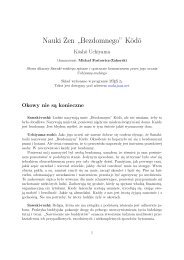

![wywiadu z Murakami Kosho Roshim [PDF] - Buddyzm w Polsce i na ...](https://img.yumpu.com/45809746/1/184x260/wywiadu-z-murakami-kosho-roshim-pdf-buddyzm-w-polsce-i-na-.jpg?quality=85)
